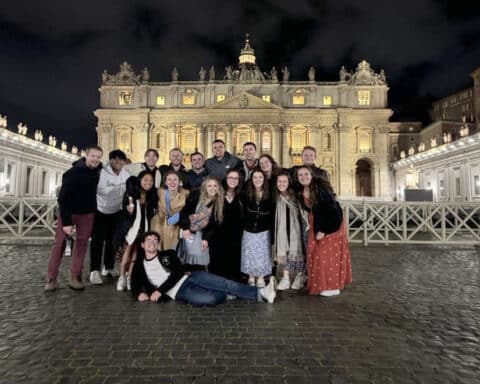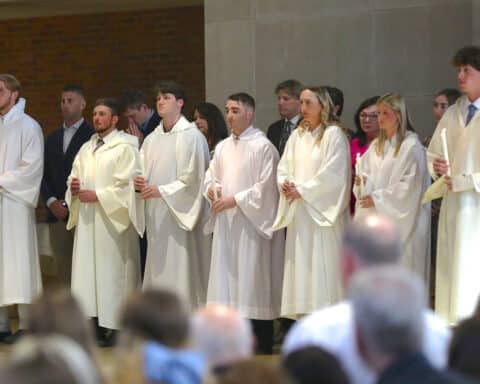Studying Church history is more than learning a timeline of saints, leaders and incidents through the centuries. It goes beyond recognizing the Church’s many contributions to science, the arts and the causes of justice, peace and health care — even the development of higher education itself.
The history of the Church is the foundation of how we live today.
“We can’t talk about what the Church believes and teaches without some reference to how the Church has shaped its teachings,” said Susan Timoney, an instructor for 15 years at The Catholic University of America in Washington, D.C. “Reminding students that the big questions we are asking today have been asked before, and so it makes sense to look backward as well as forward.”
Timoney is associate professor of practice (Pastoral Studies Area) and associate dean for undergraduate studies in the School of Theology and Religious Studies. She noted that making a compelling case for studying any history can be a challenge in a culture that thinks ancient history is the period of time before the internet was invented.
Read more Fall College Section articles here.
That challenge is being met on Catholic campuses through a variety of courses that delve into the story of the Church.
“Many students who choose Catholic University do so because they have an interest in learning more about their faith,” Timoney said. “So we have a good mix of majors and non-majors in our Church history courses. I think young Catholics recognize the unique place the Church has in society as an institution with a 2,000-year history, and so making sense of that story is of interest. The secularization of society has raised a number of serious and complicated questions related to what it means to be human, the nature of truth and what is the place of religion in society.”
Other students, she added, are attracted to taking a deeper dive into the idea of truth and how it has been expressed in Judeo-Christian tradition.
“It’s important to help students see the Church’s history as a living story, the continuing unfolding of God’s plan of salvation,” Timoney said. “It’s particularly important today to see the pattern of growth, reform and renewal that makes up that history. We hope that our students can see themselves in the unfolding story, and so the Church’s story is our story.”
Simon des Rosiers of Salmouch, Maine, a junior at The Catholic University of America, is majoring in religious studies with a minor in Church history.
“If I become a Church history professor, I could hand this information on to the next generation,” he said. “I’m discerning vocation, and if I become a priest, I’ll know what the Church has gone through in its time on earth, and I will be able to teach that.”
Des Rosiers said studying theology and history offers tremendous insight into how we interact with the divine and how the divine interacts with us.
“There are things to know about the Catholic Church, and the pilgrim Church had its black marks and has gone through trials,” he said. “There’s hope in that, and in passing on to the next generation of future Catholics that there will be suffering on this pilgrimage on earth. Through Church history, we learn how our ancestors struggled and had sufferings. But through the truth of Jesus Christ, they were able to receive trials and to find hope. That’s why these courses are important. If we don’t know our history, how can we really know ourselves in the present day?”
Looking back, looking forward
Ann Brodeur noted that most students who major in Catholic studies at the University of Mary in Bismarck, North Dakota, want to serve the Church in some way. But what they learn can serve them in being a virtuous leader in any career path.
“We talk to a lot of our students about the great task of raising all sectors of work and society to Christ,” Brodeur said. “That conversation begins in the Great Catholic Adventures course.”
Brodeur, an associate professor in the Department of History of Catholic Studies, has been teaching the course for six years. She describes it as being anchored around the Six Ages of the Church — the work of the late Christopher Dawson, whom many consider the greatest English-speaking Catholic historian of the 20th century.
“Dawson argues that the Church in every age since the very beginning has been beset by challenges, which it has creatively engaged and overcome, leading to a flowering of thought, art and life,” Brodeur said. “When a student has obtained a glimpse of the ‘long view’ that Dawson offers, it enables a kind of prudence, wisdom and hope, especially in a world that seems so topsy-turvy and in a Church that is suffering. We talk a lot about providence, how it’s no accident that they were born into this place and this time — this age of change — and that they have an important role to play. Students come away with a sense of hope and a renewed commitment to making Christ known and to serving the Church in the world.”
Maggie Vincent of Hoquiam, Washington, is a graduate student in Catholic Studies at the University of Mary. She credits The Great Catholic Adventure course with revealing the perennial truths of the Catholic faith being tailored to the human person in every respect and in every age.
“Dr. Brodeur connected what we found in the pre-Christian stories and asked us to explore how those same desires and questions continue through the ages of the Church in the lives of Christians — from St. Augustine to St. Thérèse of Lisieux,” she said. “It became clear to me that the need for the Incarnation was being anticipated as early as Ancient Greek philosophers. When Christ became man, it fulfilled a mystery that humans had been pondering years before. I came to understand more deeply the power of the Incarnation and its ability to transform and elevate man’s perennial questions to answers that satisfy completely.”
The class taught her to see the Catholic Church as the Body of Christ operating within time and intentionally bringing the people of each age back to Christ.
“The topics covered in the course are imperative for my generation,” Vincent said, “as they provide context to our story as Catholics in this world and should propel us to action.”
Maryann Gogniat Eidemiller writes from Pennsylvania.





